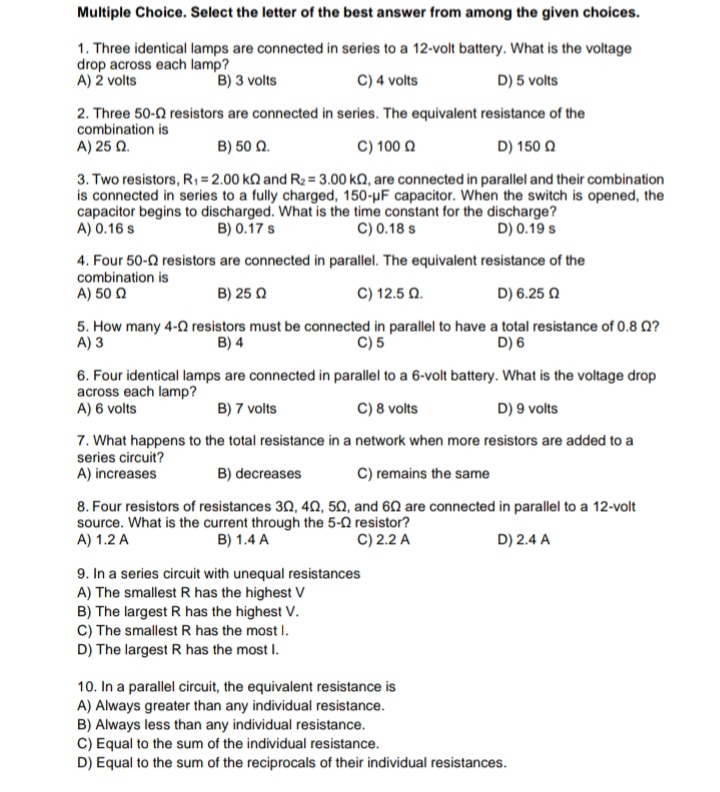1. Three identical lamps are connected in series to a 12-volt battery. What is the voltage drop across each lamp? A) 2 volts B) 3 volts C) 4 volts D) 5 volts
1. Three identical lamps are connected in series to a 12-volt battery. What is the voltage drop across each lamp? A) 2 volts B) 3 volts C) 4 volts D) 5 volts
Physics for Scientists and Engineers with Modern Physics
10th Edition
ISBN:9781337553292
Author:Raymond A. Serway, John W. Jewett
Publisher:Raymond A. Serway, John W. Jewett
Chapter27: Direct-current Circuits
Section: Chapter Questions
Problem 45AP
Related questions
Question
Please answer the questions below thank you. Just give the letter of the correct answer no need to give solutions. please answer 1 to 10

Transcribed Image Text:Multiple Choice. Select the letter of the best answer from among the given choices.
1. Three identical lamps are connected in series to a 12-volt battery. What is the voltage
drop across each lamp?
A) 2 volts
B) 3 volts
C) 4 volts
D) 5 volts
2. Three 50-Q resistors are connected in series. The equivalent resistance of the
combination is
A) 25 Q.
B) 50 0.
C) 100 0
D) 150 0
3. Two resistors, R; =2.00 kN and R2 = 3.00 kN, are connected in parallel and their combination
is connected in series to a fully charged, 150-uF capacitor. When the switch is opened, the
capacitor begins to discharged. What is the time constant for the discharge?
A) 0.16 s
B) 0.17 s
C) 0.18 s
D) 0.19 s
4. Four 50-Q resistors are connected in parallel. The equivalent resistance of the
combination is
A) 50 2
B) 25 0
C) 12.5 Q.
D) 6.25 0
5. How many 4-0 resistors must be connected in parallel to have a total resistance of 0.8 0?
A) 3
C) 5
B) 4
D) 6
6. Four identical lamps are connected in parallel to a 6-volt battery. What is the voltage drop
across each lamp?
A) 6 volts
B) 7 volts
C) 8 volts
D) 9 volts
7. What happens to the total resistance in a network when more resistors are added to a
series circuit?
A) increases
B) decreases
C) remains the same
8. Four resistors of resistances 30, 40, 50, and 60 are connected in parallel to a 12-volt
source. What is the current through the 5-0 resistor?
A) 1.2 A
B) 1.4 A
C) 2.2 A
D) 2.4 A
9. In a series circuit with unequal resistances
A) The smallest R has the highest V
B) The largest R has the highest V.
C) The smallest R has the most I.
D) The largest R has the most I.
10. In a parallel circuit, the equivalent resistance is
A) Always greater than any individual resistance.
B) Always less than any individual resistance.
C) Equal to the sum of the individual resistance.
D) Equal to the sum of the reciprocals of their individual resistances.
Expert Solution
This question has been solved!
Explore an expertly crafted, step-by-step solution for a thorough understanding of key concepts.
This is a popular solution!
Trending now
This is a popular solution!
Step by step
Solved in 3 steps

Knowledge Booster
Learn more about
Need a deep-dive on the concept behind this application? Look no further. Learn more about this topic, physics and related others by exploring similar questions and additional content below.Recommended textbooks for you

Physics for Scientists and Engineers with Modern …
Physics
ISBN:
9781337553292
Author:
Raymond A. Serway, John W. Jewett
Publisher:
Cengage Learning

Physics for Scientists and Engineers
Physics
ISBN:
9781337553278
Author:
Raymond A. Serway, John W. Jewett
Publisher:
Cengage Learning

Physics for Scientists and Engineers, Technology …
Physics
ISBN:
9781305116399
Author:
Raymond A. Serway, John W. Jewett
Publisher:
Cengage Learning

Physics for Scientists and Engineers with Modern …
Physics
ISBN:
9781337553292
Author:
Raymond A. Serway, John W. Jewett
Publisher:
Cengage Learning

Physics for Scientists and Engineers
Physics
ISBN:
9781337553278
Author:
Raymond A. Serway, John W. Jewett
Publisher:
Cengage Learning

Physics for Scientists and Engineers, Technology …
Physics
ISBN:
9781305116399
Author:
Raymond A. Serway, John W. Jewett
Publisher:
Cengage Learning

College Physics
Physics
ISBN:
9781938168000
Author:
Paul Peter Urone, Roger Hinrichs
Publisher:
OpenStax College

College Physics
Physics
ISBN:
9781285737027
Author:
Raymond A. Serway, Chris Vuille
Publisher:
Cengage Learning

College Physics
Physics
ISBN:
9781305952300
Author:
Raymond A. Serway, Chris Vuille
Publisher:
Cengage Learning